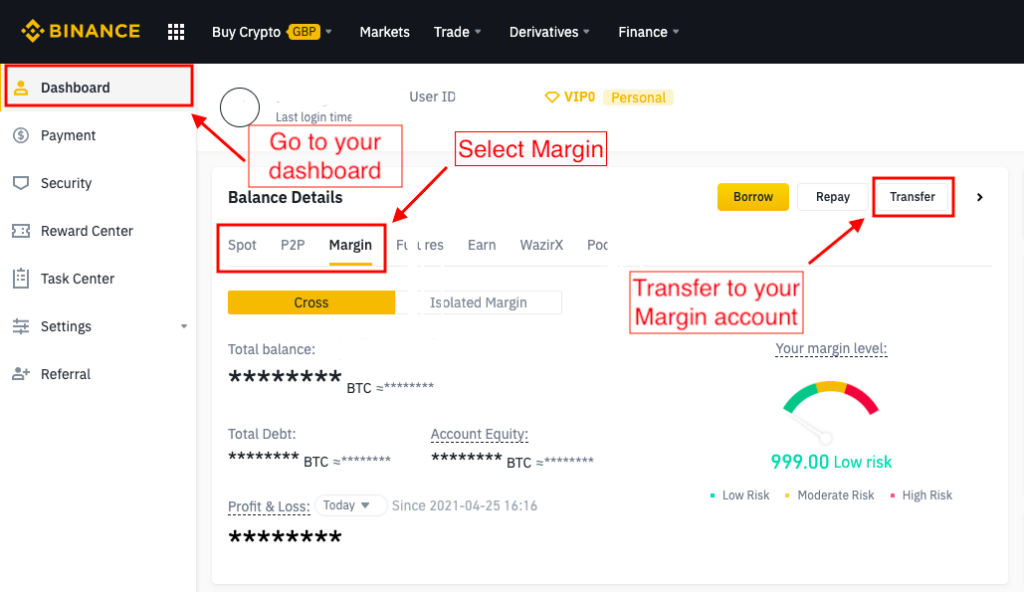Crypto Margin Trading – Tutorial & Best Exchanges



With a boom in cryptocurrency, margin trading on this volatile asset provides new and potentially lucrative opportunities. In this tutorial, we explain how to trade crypto on margin plus offer tips for choosing the best exchanges and platforms. We also cover the pros and cons of crypto margin trading and a guide to getting started.
Crypto Margin Trading Platforms
This is why we think these brokers are the best in this category in 2025:
- Plus500US - Plus500’s Micro-Bitcoin and Micro-Ethereum futures only allow traders to scratch the surface of crypto trading with bets on the two most popular digital assets. Importantly, you cannot buy and own the cryptos with these derivative contracts - you are speculating on their price.
- NinjaTrader - You can get exposure to micro Bitcoin futures through the CME Group’s centralized exchange, which is highly regulated by the US CFTC. Micro contracts allow you to trade a fractional size of one Bitcoin, giving you more risk control and order flexibility.
- Interactive Brokers - IBKR lets you purchase and hold Bitcoin, Bitcoin Cash, Ethereum, and Litecoin at competitive commission rates and without needing a crypto wallet. Additionally, there is a range of other diverse assets to explore, such as crypto indices like the NYSE Bitcoin Index, as well as futures contracts like the BAKKT Bitcoin Futures.
- OANDA US - Cryptocurrency trading is offered via Paxos, a separate entity from Oanda. You can speculate on the world’s biggest cryptos by market cap. Commissions are lower than many peers starting at 0.25%. Through the broker’s partnership with Paxos, clients can spot trade cryptocurrencies on the itBit exchange through the OANDA native platform.
- IQCent - IQCent offers a range of crypto binary assets paired with USDT, from Bitcoin through to Trump hype, which offers the highest payouts we’ve seen on any binary platform, reaching 1500%. The mix of OTC and non-OTC crypto binaries ensure around the clock trading opportunities, while the platform was fast with minimal lag during our latest tests.
- Plexytrade - Plexytrade lets traders capitalize on the inherent volatility of the cryptocurrency market by offering leveraged trading on 5 popular cryptocurrencies, including Bitcoin. However, the threadbare offering of digital tokens seriously trails leading brokers like Eightcap with its 100+ crypto derivatives.
Plus500US
"Plus500US stands out as an excellent choice for beginners, offering a very user-friendly platform, low day trading margins, and access to the Futures Academy to enhance trading skills. Its powerful tools and reliable service helped it scoop second place in DayTrading.com's annual 'Best US Broker' award."
Michael MacKenzie, Reviewer
Plus500US Quick Facts
| Coins | MicroBitcoin, MicroEthereum |
|---|---|
| Crypto Mining | No |
| Auto Market Maker | No |
| Crypto Lending | No |
| Crypto Staking | No |
| Platforms | WebTrader, App |
| Minimum Deposit | $100 |
| Regulator | CFTC, NFA |
| Account Currencies | USD |
Plus500US Leverage Trading
At Plus500US the available leverage is VariablePros
- Plus500 is a publicly traded company with a good reputation, over 24 million traders, and a sponsor of the Chicago Bulls.
- The Futures Academy is an excellent resource for new traders with engaging videos and easy-to-follow articles, while the unlimited demo account is great for testing strategies
- The straightforward account structure, pricing model and web platform offer an easier route into futures trading than rivals like NinjaTrader
Cons
- Although support response times were fast during tests, there is no telephone assistance
- The proprietary platform is user-friendly but lacks advanced technical analysis tools found in third-party solutions like MetaTrader 4
- Plus500US does not offer social trading capabilities, a feature available at alternatives like eToro US which could strengthen its offering for aspiring traders
NinjaTrader
"NinjaTrader continues to meet the demands of active futures traders looking for low fees and premium analysis tools. The platform hosts top-rate charting features including hundreds of indicators and 10+ chart types."
Tobias Robinson, Reviewer
NinjaTrader Quick Facts
| Coins | BTC |
|---|---|
| Crypto Mining | No |
| Auto Market Maker | No |
| Crypto Spread | Floating |
| Crypto Lending | No |
| Crypto Staking | No |
| Platforms | NinjaTrader Desktop, Web & Mobile, eSignal |
| Minimum Deposit | $0 |
| Regulator | NFA, CFTC |
| Account Currencies | USD |
NinjaTrader Leverage Trading
At NinjaTrader the available leverage is 1:50Pros
- Traders can get free platform access and trade simulation capabilities in the unlimited demo
- NinjaTrader continues to deliver comprehensive charting software for active day traders with bespoke technical indicators and widgets
- Low fees are offered, with $50 day trading margins & commissions from $.09 per micro contract
Cons
- Non forex and futures trading requires signing up with partner brokers
- There is a withdrawal fee on some funding methods
- The premium platform tools come with an extra charge
Interactive Brokers
"Interactive Brokers is one of the best brokers for advanced day traders, providing powerful charting platforms, real-time data, and customizable layouts, notably through the new IBKR Desktop application. Its superb pricing and advanced order options also make it highly attractive for day traders, while its diverse range of equities is still among the best in the industry."
Christian Harris, Reviewer
Interactive Brokers Quick Facts
| Coins | BTC, LTC, ETH, XRP |
|---|---|
| Crypto Mining | No |
| Auto Market Maker | No |
| Crypto Spread | 0.12%-0.18% |
| Crypto Lending | No |
| Crypto Staking | No |
| Platforms | Trader Workstation (TWS), IBKR Desktop, GlobalTrader, Mobile, Client Portal, AlgoTrader, OmniTrader, TradingView, eSignal, TradingCentral, ProRealTime, Quantower |
| Minimum Deposit | $0 |
| Regulator | FCA, SEC, FINRA, CFTC, CBI, CIRO, SFC, MAS, MNB, FINMA, AFM |
| Account Currencies | USD, EUR, GBP, CAD, AUD, INR, JPY, SEK, NOK, DKK, CHF, AED, HUF |
Interactive Brokers Leverage Trading
At Interactive Brokers the available leverage is 1:50. Margin rate is 1.55 - 2.59%Pros
- With low commissions, tight spreads and a transparent fee structure, IBKR delivers a cost-effective environment for short-term traders.
- Interactive Brokers has launched ForecastTrader, a unique, zero-commission product where users can trade yes/no Forecast Contracts on political, economic, and climate events, with fixed $1 payouts per contract, 24/6 market access, and 3.83% APY on held positions.
- Interactive Brokers has been named Best US Broker for 2025 by DayTrading.com, recognizing its long-standing commitment to US traders, ultra-low margin rates, and global market access at minimal cost.
Cons
- IBKR provides a wide range of research tools, but their distribution across trading platforms and the web-based 'Account Management' page lacks consistency, leading to a confusing user experience.
- TWS’s learning curve is steep, and beginners may find it challenging to navigate the platform and understand all the features. Plus500's web platform is much better suited to new traders.
- Support can be slow and frustrating based on tests, so you might find it challenging to reach customer service representatives promptly or encounter delays in resolving issues.
OANDA US
"OANDA remains an excellent broker for US day traders seeking a user-friendly platform with premium analysis tools and a straightforward joining process. OANDA is also heavily regulated with a very high trust score."
Jemma Grist, Reviewer
OANDA US Quick Facts
| Coins | BTC, ETH, LTC, BCH, PAXG, LINK, UNI, AAVE |
|---|---|
| Crypto Mining | No |
| Auto Market Maker | No |
| Crypto Spread | $100 |
| Crypto Lending | No |
| Crypto Staking | No |
| Platforms | OANDA Trade, MT4, TradingView, AutoChartist |
| Minimum Deposit | $0 |
| Regulator | NFA, CFTC |
| Account Currencies | USD, EUR, GBP, CAD, AUD, JPY, CHF, HKD, SGD |
OANDA US Leverage Trading
At OANDA US the available leverage is 1:50. Margin rate is 2%Pros
- There's a strong selection of 68 currency pairs for dedicated short-term forex traders
- OANDA is a reliable, trustworthy and secure brand with authorization from tier-one regulators including the CFTC
- The proprietary OANDA web platform continues to deliver a highly competitive charting environment, including 65+ technical indicators powered by TradingView
Cons
- The range of day trading markets is limited to forex and cryptos only
- There's only a small range of payment methods available, with no e-wallets supported
- It's a shame that customer support is not available on weekends
IQCent
"IQCent is great for traders wanting bespoke binary assets, with a growing roster of 150+ products, including ‘Hype Pool’ contracts, which track trending events. Short-term expiries from 5 seconds, payouts that can hit 95% (with up to a 3% boost), and a TradingView charting package with 100+ indicators, also make it ideal for serious, fast-paced traders."
Jemma Grist, Reviewer
IQCent Quick Facts
| Coins | BTC, ETH, LTC, ETC, DOGE, MATIC, QNT, SOL, XRP, USDT, XMR, BNB |
|---|---|
| Crypto Mining | No |
| Auto Market Maker | No |
| Crypto Spread | Variable |
| Crypto Lending | No |
| Crypto Staking | No |
| Platforms | Online Platform, TradingView |
| Minimum Deposit | $250 |
| Account Currencies | USD, EUR |
IQCent Leverage Trading
At IQCent the available leverage is 1:500Pros
- IQCent has bolstered its asset range with 60+ new assets, including hot cryptos like TON and SHIB; top-tier stock CFDs such as TSLA and NVDA; plus exotic FX pairs like THB and HUF
- IQCent is one of the few binary options brokers that also offers a copy trading service for hands-off traders
- Keen traders can take part in trading contests with cash prizes
Cons
- The market analysis is very basic with limited technical summaries and insights from analysts
- The broker is not overseen by a respected regulator, though this is common among binary options firms
- IQCent trails binary brokers like Quotex with its narrow investment offering of around 175 assets with limited stocks
Plexytrade
"Plexytrade is a newcomer in the brokerage scene with attention-grabbing features like 1:2000 leverage, zero spreads on select instruments and fast execution speeds of less than 46 milliseconds. However, the absence of regulation is a significant concern, while the non-existent research and educational tools place it far behind industry frontrunners."
Christian Harris, Reviewer
Plexytrade Quick Facts
| Coins | BTC, ETH, LTC, SOL, XRP |
|---|---|
| Crypto Mining | No |
| Auto Market Maker | No |
| Crypto Spread | 1.1 |
| Crypto Lending | No |
| Crypto Staking | No |
| Platforms | MT4, MT5 |
| Minimum Deposit | $50 |
| Account Currencies | USD, EUR |
Plexytrade Leverage Trading
At Plexytrade the available leverage is 1:2000Pros
- There are various VPS packages starting from $50 per month, but they become complimentary once specific deposit thresholds are reached.
- US residents are accepted as clients, distinguishing Plexytrade as one of the rare offshore brokers that cater to US-based traders.
- Plexytrade accommodates a range of trading methods and short-term strategies, including scalping, hedging, and automated trading.
Cons
- Plexytrade lacks regulation in major jurisdictions, significantly increasing the risks of opening an account and depositing funds.
- Deposits and withdrawals are exclusively facilitated through cryptocurrencies, as Plexytrade does not support bank cards, bank wire transfers, or e-wallets.
- With around 100 instruments, Plexytrade restricts the flexibility of investors who prefer to trade across various assets, especially compared to Blackbull with its 26,000 securities.
What Is Crypto Margin Trading?
Crypto margin trading is the practice of using leverage to multiply the results of a trade. The amount a trader has deposited in their account is known as the margin.
A broker offering margin trading will provide traders with a leverage quote, this is usually displayed as either a ratio (e.g 1:2) or a multiple (e.g 2x), meaning that for every 1 base crypto coin, the results of a trade are multiplied by 2.
To enable traders to open larger positions, the broker allows them to borrow capital. This will need to be paid back in full, but the profits can be retained by the trader.
For example, if your leverage is 1:2 and you deposit $1,000, you can open positions with a total value of $2000.
If you use this to purchase Ethereum and the price moves 5%, you’ll have $2,100 worth of ETH.
If you close your trade there and return the $1,000 borrowed, you’re left with $1,100, having made a $100 profit.
If you’d placed the same trade in your spot account, you’d have made a $50 profit.
It’s important to note that profits are amplified, but equally, so are losses. Plus, your borrowed amount will still need to be returned. Therefore, margin trading on cryptos should only be utilised by knowledgeable investors.
Some of the top crypto exchanges now offer crypto margin trading, including Binance, Kraken and Crypto.com. However, it is a fairly new practice, so some of the top brokers for professionals, such as TradeStation, are yet to facilitate crypto margin trading.
What Is A Margin Call?
If the price of the asset held on margin drops in value significantly, a broker will issue a margin call. This means that traders will have to prove that they can return the amount borrowed, by depositing more funds.
The account will usually be suspended from opening new trades until this has been completed, or the asset rises in value again.
A margin call is designed to protect traders from losing more than they can afford.
For example, if you’re trading $1,000 on margin with 5x leverage and the value of ETH drops 17.5%, the value of the asset you hold is now worth $4,125.
Your operating loss is -$875. Since you’ve only deposited $1,000, you’re in danger of losing more than your initial deposit amount if the value slips further. At this point, a margin call may be issued.
Pros Of Crypto Margin Trading
- Lower capital requirements – Some Bitcoin trading strategies that require large amounts of capital. For example, scalping is the practice of executing short and sharp trades to collect small profits regularly. Crypto margin trading allows traders to maximise the results of each trade and means profits can accumulate quickly.
- 24/7 margin trading – Unlike the forex and commodities markets, crypto can be traded 24/7. If you’re a weekend trader, this means you can take advantage of margin trading outside of usual operating hours.
Cons Of Crypto Margin Trading
- Losses are amplified – While crypto trading on margin can mean increased profits, it also means that any losses are multiplied. Losses can exceed the deposit amount, so the risk involved is significantly larger when compared with trading on a cash account. Traders should consider whether they can afford the risk.
- Interest on borrowed crypto – While traders keep all the profits from their trades, some exchanges, such as Binance, charge interest on the borrowed amount. The rate varies based on the cryptocurrency and the length of time capital is borrowed.
- Negative balance protection – In the world of forex, margin trading has been around a while. Therefore, most brokers are subject to regulation that aims to protect retail investors. In the UK, forex brokers regulated by the Financial Conduct Authority (FCA) must provide negative balance protection, for example. This means that traders are prevented from losing more than their deposit amount when trading on margin. This level of protection is not available in the crypto industry, leaving altcoin margin traders exposed to significant risk.
- Brokers and exchanges – Having mentioned the lack of regulation above, there is a global tightening of restrictions that is already impacting the availability of crypto margin trading. In 2020, Coinbase Pro, one of the top Bitcoin exchanges, suspended margin trading for US customers, citing new guidance from the Commodity Futures Trading Commission (CFTC). Binance and Robinhood also restrict margin trading on cryptos for US customers and eToro has suspended it at times due to volatility. These restrictions could increase and margin trading on crypto assets phased out on Bitcoin exchanges in the US and potentially other jurisdictions too.
- Limited trading pairs – Not all crypto margin trading platforms offer leverage on all pairs, sometimes it’s only available on one or two. This limits traders’ scope for utilising an arbitrage strategy. For example, crypto.com only offers margin trading on BTC/USDT.
How To Start Crypto Margin Trading
To start crypto margin trading, you’ll first need to select a broker or an exchange that provides the service. Some of the best crypto exchanges that offer margin trading include Binance and Kraken. Then sign up to an account and complete any KYC checks. Most exchanges will require proof of identity if they also offer fiat exchange, however, there are some, such as Prime XTB, which have no KYC checks. Next, visit your settings. There will usually be an option to switch your account from spot to margin trading. In some cases, you’ll then need to transfer tokens to your margin account.

Choosing A Crypto Margin Trading Broker
- Leverage offered – Take a look a what leverage a broker is offering to understand how much you can trade. If you’re happy with the risks involved, higher leverages can mean higher profits, but they’re not always necessary. Both Binance and Kraken offer leverage of 1:5 when crypto margin trading. Crypto.com offers 1:3 and IC Markets offers 1:2.
- Fees – The fee structure for margin trading varies per broker. Some operate by allowing traders to borrow tokens as leverage, including Binance. In this instance, interest is usually charged on the borrowed amount. Kraken, on the other hand, charges an opening and closing fee on the spot value of the trade. A rollover fee is applied based on how long the position is held. Look for a broker whose fee structure you’re comfortable with. Also, taxes will usually need to be paid on any gains, in line with rules in your jurisdiction.
- Demo accounts – Since Bitcoin margin trading involves an increased level of risk, traders must have the opportunity to practice their strategies using signals beforehand. A trading simulator and online courses allow clients to trial strategies before using real money. Profit calculators are also useful to help predict the outcome of a trade and can replace the manual spreadsheet you’ve previously worked with. Plus500 offers a great CFD crypto-simulator with 2x leverage, however this is only available on their professional trading account.
Final Word On Crypto Margin Trading
Now we’ve explained the ins and outs of crypto margin trading, you’ve hopefully got the understanding to get started. Bitcoin and other cryptos are highly volatile markets and while trading on margin can mean huge upside, retail investors should also be aware of the risks involved. It’s possible this asset could suffer from increased regulation in the future, but for now, it represents an exciting opportunity for traders.
FAQ
How Does Bitcoin Margin Trading Work?
Crypto margin trading means investors can multiply the results of their Bitcoin trade by utilising leverage. Leverage is the number of times you can multiply the results, it is either written as a ratio (e.g 1:3) or a multiple (e.g 3x). Leverage allows traders to borrow funds from their broker. In this way, a trader can execute much larger positions than their deposit amount and can amplify profits.
Are There Many Crypto Exchanges That Allow Margin Trading?
The top crypto margin trading exchanges that allow margin trading include Kraken and Binance, but there are more to choose from. However, availability does vary by location. Some popular exchanges, including eToro and Coinbase, have suspended crypto margin trading at times due to volatility in the market.
Is Crypto Margin Trading Legal In The USA?
Bitcoin margin trading in the United States is restricted by the Commodity Futures Trading Commission (CFTC). Regulated exchanges that previously offered the service, such as Coinbase and Binance, have removed leveraged trading in 2021 for clients from the USA.
Will A Crypto Margin Call Go Away?
A margin call will cease once your account has been deposited with sufficient funds or the asset has increased in value. A margin call is designed to protect a trader from losses that exceed their deposit amount.
Can I Trade Crypto On Margin?
Yes, some of the top Bitcoin exchanges now offer trading on margin, with the opportunity to multiply the results of any trade. Whilst the practice is restricted in some jurisdictions, like the US, it is available in the UK, Australia, India, and Canada, to name just a few.





